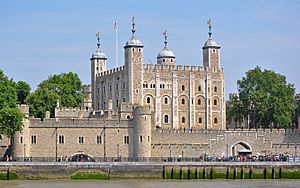William Rainsborowe facts for kids
Quick facts for kids
Major-General
William Rainsborowe
|
|
|---|---|
| Born | 1612 Wapping, London, England
|
| Died | 19 December 1673 (aged 61) |
| Education | Magdalene College, Cambridge |
| Occupation | Mariner, Businessman |
| Known for | Adventurer, Parliamentarian, Leveller, Amongst the first English Colonists of New England |
| Signature | |
William Rainsborowe (born around 1612, died 1673) was an important officer in the English Navy and Army during a very exciting time in England's history. He lived through the English Civil War and the period right after, known as the Interregnum. William was known for his strong beliefs about fairness and freedom, and he was also one of the first English settlers in New England in North America.
Contents
Early Life and Family Connections
William Rainsborowe's exact birth details are a bit of a mystery. We know he was likely born in Wapping, London, England. This is because his brother, Thomas Rainsborough, who was also a famous figure, was born there. Their father, also named William Rainsborough, was a high-ranking officer in the Royal Navy. He was even an ambassador to Morocco!
William Rainsborowe owned property in London, including in Wapping and Shadwell. He also had a home in Putney. His brother Thomas stayed there during the famous Putney Debates in 1647. William studied at Magdalene College, Cambridge, which was a well-known university.
Adventures in New England
In the 1630s, William moved to the Massachusetts Bay Colony in America with his sisters. He lived in a place called Charlestown and joined the local army, called the militia, in 1639.
William and his brother Thomas also went on an adventure to another Puritan colony. This was the Providence Island colony, located off the coast of Nicaragua. Unfortunately, the Spanish took control of Providence Island in 1641.
Returning to England and the Civil War
William came back to England in 1642 after his father passed away. Soon after, he married Margery Jenney from Suffolk. Almost immediately, he joined the Navy. When a war started in Ireland during the Irish Rebellion of 1641, he was part of the English forces sent there.
By 1644, William became an officer in a cavalry unit, which meant he led soldiers on horseback. Both William and his brother Thomas were part of a group called the Levellers. This group believed in more equal rights for everyone. They were also likely members of "Independents" churches, which were against the official Church of England.
Key Battles and Debates
William Rainsborowe fought bravely in The Battle of Naseby on June 14, 1645. He fought alongside his brother, Colonel Thomas Rainsborough. William was a Captain in the New Model Army, which was Parliament's army.
However, William quickly showed his strong beliefs. In May 1647, he spoke out against his own Colonel, Thomas Sheffield. William told Parliament's leaders that the army was unhappy and explained his men's complaints. Because of this, Colonel Sheffield was removed, and William was promoted to Major. He then served under Colonel Thomas Harrison.
The discussions at Saffron Walden in 1647 led to the more famous Putney Debates later that year. During these debates, the army demanded more rights and freedoms. These discussions, along with a Second English Civil War (1648–1649), eventually led to England becoming a republic called the Commonwealth of England (1649–60).
William showed his Leveller ideas during the Putney Debates. His brother, Thomas, was even more outspoken about Leveller beliefs. Sadly, Thomas was killed by Royalists (supporters of the King) in October 1648. William led his brother's funeral. A document from that time talked about William's efforts to find justice for his brother's death.
Facing Trouble: Arrest and Release
In 1659, the Rump Parliament (the part of Parliament that remained after the King was executed) made William a Colonel. He was asked to gather his own group of soldiers. But then, the Rump Parliament itself was dissolved.
William protested this change by signing a document called A Remonstrance and Protestation of the Well-Affected People. He then tried to sell the weapons he had bought for his soldiers. Selling many pistols during a time when England was changing from a republic back to having a King was seen as a very risky move.
Because of this, William was arrested in December 1660. This was during the time known as the Restoration, when the King was brought back to power. He was put in the Tower of London in December 1660. He was later released on bail in February 1661. Major Rainsborowe became one of many famous people held in the Tower of London.
Later Life and Death
After being released on bail, William Rainsborowe left England. We don't know much about what he did next until his death in 1673. He passed away in Boston, New England, where he had lived before.
Images for kids





